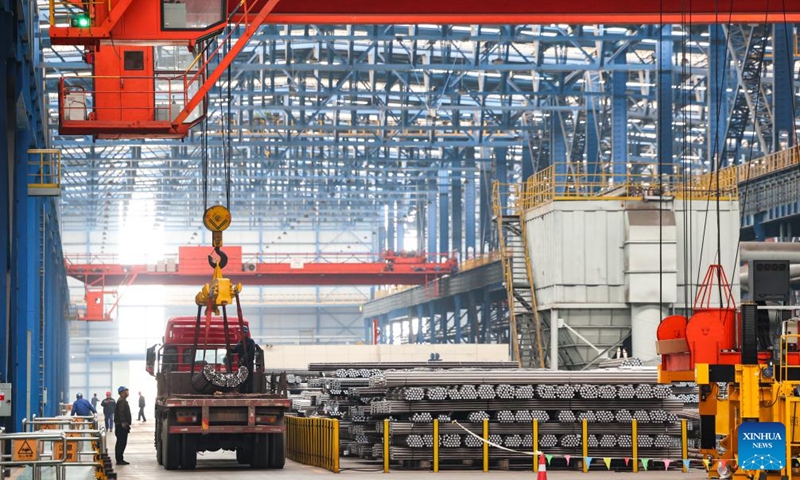MIIT to launch new growth plans for 10 key industries, increase support for major industrial provinces

Workers of HBIS Group Shijiazhuang Iron and Steel Co., Ltd. hoist steel for transport in Shijiazhuang, north China's Hebei Province, Jan. 2, 2025. Enterprises across China are operating at full capacity to meet production demands at the start of the new year. (Liang Zidong/Xinhua)
China's Ministry of Industry and Information Technology (MIIT) will roll out a new round of growth initiatives for 10 key industries, and increase support for major industrial provinces and cities, officials said on Tuesday.
The 10 key industries are steel, non-ferrous metals, petrochemicals, chemicals, building materials, machinery, automobiles, power equipment, light industry, and electronics. These industries together account for about 70 percent of the industrial added value of sectors above the designated size, according to the MIIT.
In 2024, the MIIT deepened the implementation of growth plans for 10 key industries and supported major industrial provinces in taking a leading role. China's total industrial added value reached 40.5 trillion yuan ($5.54 trillion), with the manufacturing sector maintaining its top position globally for the 15th consecutive year, Zhang Yunming, vice minister of the MIIT, said at a press conference in Beijing.
The value added of the information transmission, software, and IT services sectors accounted for 4.7 percent of GDP. The industrial and information technology sectors contributed more than 40 percent to economic growth, effectively serving as key "stabilizers" for the economy, Zhang said.
The momentum for the growth of China's industrial economy further strengthened in 2024. This was reflected in a 7.7 percent year-on-year increase in the value-added of large-scale equipment manufacturing, contributing 46.2 percent to the overall growth of industrial sectors above the designated size. Meanwhile, innovation in high-end equipment and artificial intelligence further advanced, while emerging industries such as new materials, biomanufacturing, and robotics grew rapidly, according to Zhang.
Given the three characteristics of being large in scale, highly interconnected, and having strong driving power in the 10 key industries, focusing on their development allows for steady growth at a lower cost, and promotes transformation and upgrading. It could help achieve a dual leap in both scale and quality for China's economy, Pan Helin, a member of the Expert Committee for the Information and Communication Economy under the MIIT, told the Global Times on Tuesday.
The MIIT also vowed to increase support for major industrial provinces and cities. "It will improve policies and mechanisms to promote the orderly transfer of industries, support regions in developing and expanding their unique and competitive sectors, and make greater contributions to industrial economic growth," Zhang said.
As a leading industrial powerhouse, the industrial output of South China's Guangdong Province exceeded 20 trillion yuan in 2024, with revenue from industrial enterprises above the designated size surpassing 19 trillion yuan, according to the Xinhua News Agency.
Zhang noted that positive factors continued to accumulate in the industrial economy. Particularly under the support of the "two new" policies - large-scale equipment renewals and replacing old consumer goods with new ones -- investment in the purchase of equipment and tools grew by 15.7 percent year-on-year, contributing an additional 2.2 percentage points to overall investment growth.
The MIIT plans to intensify efforts to promote the "two new" policies in 2025, Zhang said.
The ministry will also intensify efforts to promote the high-quality development of key manufacturing industry chains, drive the transformation and upgrading of traditional industries, promote innovation in emerging and future industries, support the specialized and innovative development of small and medium-sized enterprises, and cultivate new quality productive forces.
Chinese companies are highly driven by innovation. In recent years, China's manufacturing sector has flourished, and its well-established supply chain provides a solid foundation for the growth of new industries. Coupled with a strong talent pool, China holds a significant advantage in the development of emerging and future industries, Pan said.
Photos
Related Stories
- China's industrial development in 2024: accelerating toward intelligent manufacturing
- GAC unveils measures to boost development of western regions
- Factbox: China makes more high-quality development progress in 2024
- Fastener industry thrives in Yongnian district, N China's Hebei
- Seven ministries launch joint plan to drive retail industry upgrade amid efforts to boost consumption
Copyright © 2025 People's Daily Online. All Rights Reserved.









